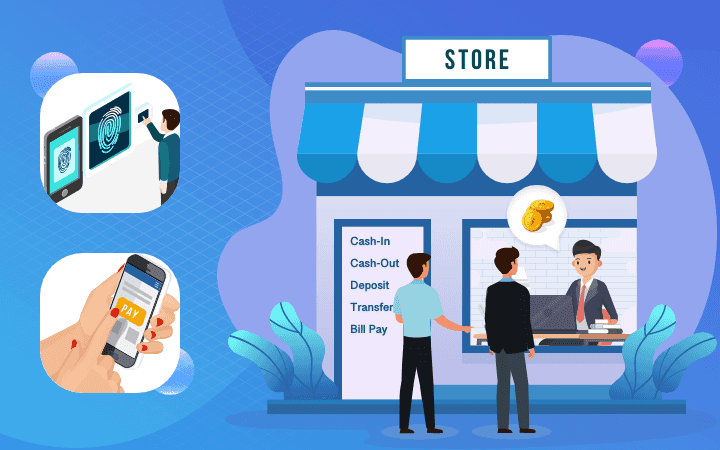
The COVID-19 epidemic has posed unexpected problems to the world economy. Global trade has experienced a dramatic downturn, and there are also problems with liquidity, credit availability, interrupted revenue streams, bad debts, and access to capital. Consumers who lack access to basic financial services have suffered the most. In many developing nations, branchless banking—the use of alternate delivery channels including mobile banking and agent banking—is growing in popularity among commercial banks. Branchless banking is thought to enhance the use of financial services among financially excluded individuals, and it is thus becoming more popular in many developing nations.
Financial inclusion is the practice of using formal financial services including credit, savings, insurance, and remittances. The importance of having access to basic financial services has been strongly supported by a large body of research. People can use it to invest in valuable business possibilities, preserve money for the future, and safeguard themselves against unforeseen shocks.
Branchless Banking
Branchless banking refers to the provision of financial services outside of conventional banking branches. With the primary client connections being retail agents or third-party intermediaries and the use of card reading technologies. Technology Mobile phones and Point of Sale (POS) terminals (CGAP, 2011).
Benefits of Branchless Banking
In the following areas, the benefits of digital solutions will be most noticeable for financial inclusion:
They can provide quick, economical, and practical customer identification and verification procedures, especially when supported by tier-based now-your-customer (KYC) programs, a real-time verification infrastructure, and unique national identity numbers.
They can significantly affect supply-side economics by solving last-mile distribution and service difficulties via low-cost, pervasive digitally-enabled physical access points such as mobile phones and point-of-sale (POS) devices.
It is widespread across the ecosystem and value chain of payments. Government-to-person (G2P)3 digital payments and remittance flows can spur the use of electronic payments and aid in the creation of workable supply-side business propositions. Person-to-person (P2P)4 payments systems together with open application programming interface (API) platforms, interoperable networks, and P2All4 payments systems can maintain and advance these.
By utilizing other data sources, such as payment transaction and telecommunications data, as well as analytics, they may considerably improve credit availability. These enhance fraud detection, credit risk evaluation, and client profiling.
By using alternative, less expensive origination and distribution channels and more practical product designs, such as mobile wallets linked to savings accounts and clear goal-based savings solutions, money may be mobilized digitally. The onboarding procedure and a simple KYC might also help.
Why do banks stick to branches?
Lower identity theft risks
Face-to-face interaction at the branch helps reduce security threats while also providing clients and banks with more financial and commercial options. An often-overlooked technique of validating a customer’s identity is a tried-and-true safeguard against fraud. In-person impersonation and identity theft are significantly riskier for thieves than they are online.
Cross-selling and self-service to boost sales
JPMorgan Chase estimates that the benefits of new account creation, client loyalty, and cross-selling potential generate an additional $1 million in income per branch each year. Bankers have had considerably more time in recent years to spend on advising and maintaining customers. Since using self-service terminals to automate most day-to-day branch transactions, extra income has reduced the payback period for new branches by seven months.
Enhanced employee utilization
Stores offer advantages when they are joined together in a network in addition to their advantages as standalone units. Employee utilization is increased by dividing back-office responsibilities across busy and less busy shops. Additionally, it lowers expenses because a branch in New York would have considerably greater personnel expenditures than one in a remote area of Iowa.
Agency Banking Solution
Banks are the most important players in facilitating financial inclusion in an economy. However, banks are unable to reach out to such underserved or rural locations due to concerns including the expense of delivering a bank system and the availability of resources. Agency Banking is among the most trustworthy choices in this situation.
An efficient technique to bring the sizable unbanked and underbanked population into the banking system is through agency banking solutions. In locations with little access to financial education, a reliable agent would be far more valuable than an imposed financial institution. Agency banking involves setting up a network of brokers or non-bank retail service providers to provide necessary financial services to the doorsteps of distant populations.
The agents utilize mobile phones or Point of Sale (PoS) card readers with barcodes and biometric scanners to perform a variety of financial services. Including cash-ins and cash-outs, peer-to-peer (P2P) money transfers, remittances, and more.
Agency Banking facilitating financial inclusion?
The growing relevance of agent banking in the rural banking industry has resulted from its expanded reach. Agent bankers help financial institutions expand their reach at a minimal cost while also promoting financial inclusion. As a result, understanding how and to what degree agency banking solutions may promote financial inclusion is essential. Following are some important factors related to agency banking solutions:
- Providing basic financial services, such as deposits, withdrawals, and remittances, at a location closer to rural residents than banks or at their front door.
- Provide affordable banking services that rural banks could not.
- Ensuring 24-hour accessibility as opposed to rural bank branches, which only operate within certain hours each day.
- Using mobile banking technologies, introduce several financial options to the unbanked.
- Offering bill payment options and other utility payment services.
- Increasing the bank’s customer base by utilizing their extensive social relationships in rural places.
Fostering positive relationships with rural clients and persuading them to often utilize financial services People living in rural locations may find a branch daunting owing to a lack of knowledge, and it would not offer the same degree of comfort.
Future of branchless banking
The necessity to develop tech-based solutions that would enable rapid. Reliable and efficient banking was one of the factors contributing to the emergence of branchless banking in the financial sector. The financial sector has to proceed in the same direction as the whole system. Furthermore, virtual banking ends up being far less expensive than the conventional, department-based approach. We can see the branchless strategy dominating the market although there are 75,000 bank branches (and counting).
Few risks might get the benefits of branchless banking. For instance, biometrics and other identification techniques like face or touch ID have seen extensive use. As a result, they might not guarantee the security of online banking. Branchless can’t yet completely replace conventional at that particular time, especially when it comes to high-value transfers. The ideal system would allow consumers to confirm their identification in any of the bank branches that are currently in operation, regardless of where they are.
Digital solutions have been effectively incorporated into the economies of many developing countries. Despite the risks associated with the branchless banking model. We can still forecast that it has a bright future in the long run. This is after weighing all of the advantages and disadvantages of this model.
Conclusion
In today’s world of business and daily life, it is crucial to be able to make payments quickly and safely. Branchless does not necessarily imply better, but with the numerous benefits, it offers. We can be confident that there will be several possibilities to make excellent use of its digital offerings. Furthermore, the rise of mobile banking does not portend the abolition of conventional methods. The future of global banking is branchless banking.
It fosters numerous social connections, collective assistance activities, and public welfare initiatives in addition to enabling economic lifestyles. There will be a significant increase in digital-only banks, and traditional banks will close branches to cut expenses. However, this overall transition will greatly benefit providers of banking and fintech technologies.





